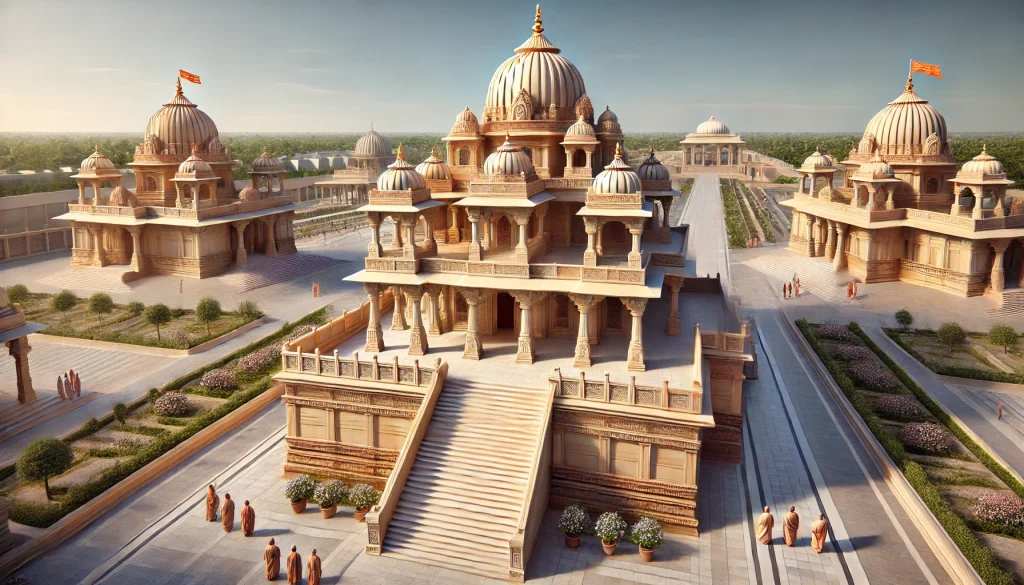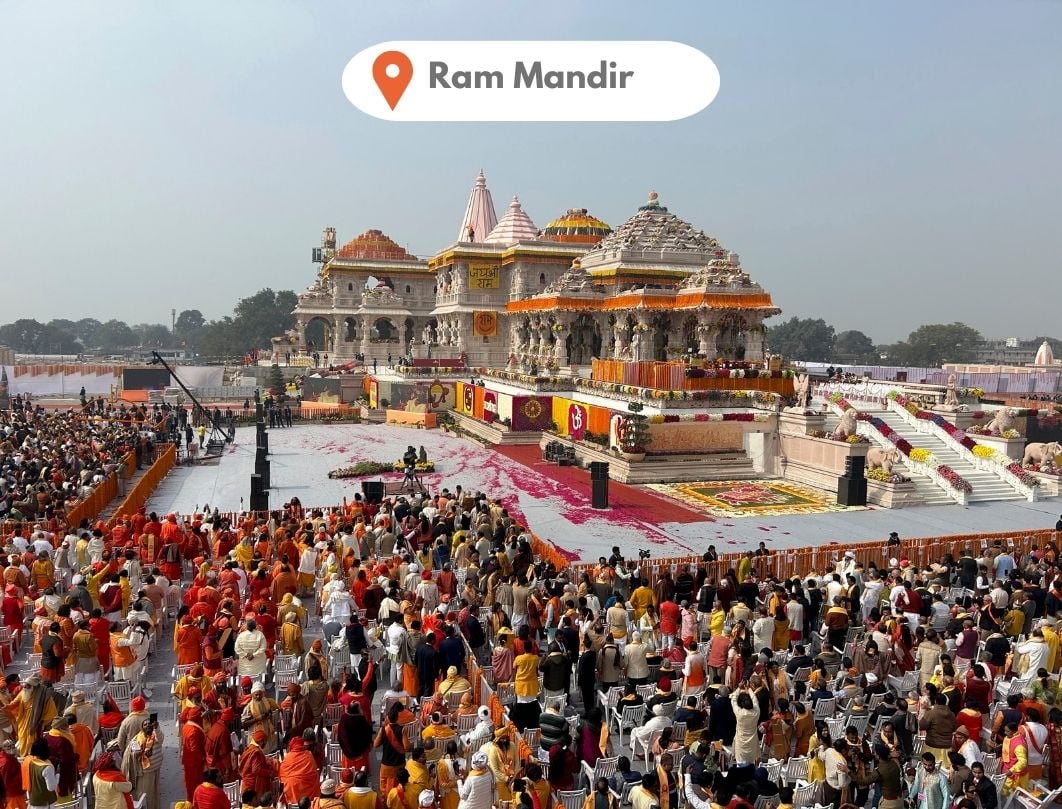Ram Mandir Ayodhya
The Ram Mandir in Ayodhya is more than a temple—it is the heart of India’s spiritual consciousness, a symbol of faith, and a testament to the enduring legacy of Lord Ram, the seventh incarnation of Lord Vishnu. Located on the sacred banks of the Saryu River, this monumental structure in Uttar Pradesh has become a national pilgrimage hub and one of the most spiritually significant destinations in the world.
As one of the most revered religious projects in modern Indian history, the Ram Mandir is a blend of mythology, devotion, history, and cultural pride. At Tripcosmos.co, we bring you a comprehensive guide to this divine landmark—covering its powerful backstory, spiritual value, and practical tips for a smooth, meaningful visit.

Ram Mandir Ayodhya
Historical Background of Ram Mandir Ayodhya
The Birthplace of Lord Ram
Ayodhya is revered in Sanatan Dharma as the Janmabhoomi (birthplace) of Lord Ram, as chronicled in the Ramayana. The spot where the Ram Mandir now stands has been venerated for millennia, believed to be the exact location where Ram Lalla (infant form of Lord Ram) was born.
Centuries of Reverence and Conflict
Over centuries, several Hindu temples stood on this sacred ground. During the Mughal era, historical accounts point to the demolition of a temple to construct the Babri Masjid in the 16th century. This act sparked centuries of religious and legal disputes, culminating in a landmark judgment by the Supreme Court of India in 2019, which allowed the construction of a new Ram Mandir at the site.
Ram Mandir Construction
- Foundation Laid: August 5, 2020, by Prime Minister Narendra Modi
- Architecture: Traditional Nagara style, using pink sandstone
- Planned Completion: Main sanctum completed and opened for devotees in January 2024
Spiritual Significance of Ram Mandir
The Ram Mandir is not just a building—it’s a symbol of dharma, justice, and national pride. For millions of Hindus across the globe, it represents the victory of good over evil and the return of Lord Ram to Ayodhya.
Symbol of Devotion and Unity
- Ram Lalla Idol: The infant form of Lord Ram sits in the sanctum sanctorum, radiating divine energy
- Cultural Reclamation: Seen as a spiritual revival of India’s dharmic roots
- Pilgrimage Center: Now among the top 5 most visited Hindu shrines in India
Ram Mandir Architecture and Design
- Total Area: 2.7 acres within a complex spread over 70 acres
- Main Temple Height: 161 feet, with 3 stories and 5 domes
- Material Used: Carved Bansi Paharpur sandstone from Rajasthan
- Design Style: Classic Nagara architecture, with detailed carvings of gods, sages, and divine symbols
- Eco-Friendly Campus: Includes Yatri Niwas, museum, research center, solar energy units, and rainwater harvesting systems
Key Features of the Ram Mandir Complex
1. Ram Janmabhoomi Sanctum
The inner sanctum houses Ram Lalla, the child deity, placed in a marble structure on a golden throne. Devotees can have darshan in a well-organized queue with ample security and guidance.
2. Mandapam and Prayer Halls
The temple has several mandapams (pillared halls) dedicated to devotional singing, discourses, and special rituals.
3. Sita Rasoi (Sita’s Kitchen)
A sacred spot within the temple premises symbolizing Mata Sita’s kitchen, showcasing ancient utensils and tools, symbolizing her devotion and simplicity.
4. Ram Katha Kunj
This is a cultural amphitheater where Ramayan-related events, bhajans, and spiritual discourses are held regularly.
How to Reach Ram Mandir, Ayodhya
By Air:
- Maharishi Valmiki International Airport, Ayodhya – Newly inaugurated, with direct flights from major cities
- Alternative Airport: Chaudhary Charan Singh International Airport, Lucknow (approx. 135 km)
By Train:
- Ayodhya Dham Junction and Faizabad Junction are the nearest railway stations.
- Well-connected to Delhi, Varanasi, Prayagraj, and other major cities
By Road:
- Excellent road connectivity via National Highways from Varanasi, Lucknow, Prayagraj, and Gorakhpur
- Tripcosmos.co offers private vehicles and AC coach tours with guides and temple assistance
Best Time to Visit Ram Mandir
Festivals to Consider:
- Ram Navami (Lord Ram’s birth anniversary, March-April)
- Diwali & Deepotsav (Grand lighting celebration with millions of diyas)
- Makar Sankranti, Dussehra, Shravan Month
Weather Considerations:
- October to March: Best for travel, cool and pleasant
- Avoid Monsoon (July-August): Heavy rains may disrupt travel plans
Essential Travel Tips for Pilgrims
- Dress Code: Modest traditional attire is recommended
- Footwear: Must be removed before entering temple premises
- Security: Multiple layers of checks—carry valid ID and avoid carrying unnecessary bags
- Photography: Restricted inside sanctum areas; follow local rules
- Prasadam: Purchase only from temple counters; many shops offer blessed items for rituals
Nearby Attractions to Visit in Ayodhya
1. Hanuman Garhi
A must-visit temple dedicated to Lord Hanuman, protector of Ayodhya. It’s customary to visit here before Ram Janmabhoomi.
2. Kanak Bhawan
Said to be gifted to Sita by Queen Kaikeyi. Beautiful idols of Ram-Sita decked in gold await devotees here.
3. Ram Ki Paidi
Ghats on the Saryu river where evening Aarti and ritual bathing take place. A spiritual spectacle not to be missed.
4. Treta Ke Thakur
An ancient temple believed to be the spot where Ram conducted the Ashwamedha Yagna.
5. Nageshwarnath Temple
One of the oldest Shiva temples in Ayodhya, with deep historical and mythological roots.
Book Your Ayodhya Pilgrimage with Tripcosmos.co
At Tripcosmos.co, we curate spiritually enriching tour packages that offer:
- VIP darshan at Ram Mandir
- Comfortable transport and guided experiences
- Ritual planning and cultural walkthroughs
- Customizable itineraries to include Prayagraj, Varanasi, Chitrakoot, Bodhgaya, and more
From the moment you step into Ayodhya, we ensure your journey is seamless, devotional, and deeply fulfilling.





